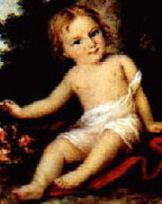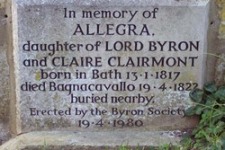A Scandal in Harrow: Illegitimate Children Part One
It’s reasonably well known that Harrow once gave home and provided schooling to a young Lord Byron one of Britain’s most famous poets. It has become difficult to think of the Romantic Movement, which celebrated the free expression of the feelings of the artist through visual art, music and literature without thinking of Byron. His infamous “mad, bad and dangerous to know” lifestyle combined with famous works such as ‘Don Juan’, ‘Childe Harold’s Pilgrimage’ and ‘She Walks in Beauty’ has seen him recognised and celebrated internationally, as well as firmly established in the literary canon.
But perhaps less well known is Harrow’s connection to another famed historical figure, Admiral Horatio Lord Nelson. Nelson has long been regarded as a national hero thanks to his naval triumphs especially during the Napoleonic Wars and the success of the Battle of Trafalgar which is said to have established British Naval supremacy. Mostly thanks to his commemoration atop Nelson’s Column in Trafalgar Square popular memory retains that he died on HMS Victory during the Battle of Trafalgar lost his right eye and right arm, although he never did wear an eye patch as is sometimes portrayed. As with many military heroes there is a tendency to focus on their successes and achievements, battle plans and strategies rather than their civilian and private lives and for a long while this was the case with Nelson, however more recently Emma Hamilton is also being remembered as part of Nelson’s legacy.
As neither character was born in Harrow or lived here for an extended period of time, it falls down to both Byron and Nelson’s children to provide the connection to Harrow, despite numerous efforts to keep the children a secret, away from the public eye and contemporary gossip.
The children, Clara Allegra Byron (12 January 1817 – 20 April 1822) and Horatia Nelson (29 January 1801 – 6 March 1881) were both illegitimate due to their parents not being married and in Horatia’s case both mother and father were married to other people.Gossip and disapproval would surround any child born in such circumstances but considering how well known their fathers were the story would easily become a national (if not international) scandal.
If anything by the time Clara Allegra Byron was born, Byron was used to scandal. It could be argued he practically encouraged it. Although it must be noted that Byron had a difficult childhood, being born with a club foot and molested by his nurse when he was 10. Whilst studying at Harrow School he was part of the group who in 1805 lead a rebellion against the Headmaster the Reverend Dr George Butler who Byron was said to find “affected, ingratiating, overbearing, boastful, pedantic and socially inadequate” by dragging the Headmasters desk into the middle of the School House and setting light to it. Local folklore has also committed to memory that Byron played in an Eton Harrow cricket match, scoring 18 runs for Harrow.
Educationally Byron moved onto Trinity College, Cambridge where he famously kept a pet bear as dogs were strictly forbidden. As his poetic talents (and financial debts) began to grow so did his reputation. In Harrow he was known to have fallen in love with fellow boys and rumour has it, slept with at least three of them. Other conquests include Caroline Cameron a 16 year old prostitute from Brighton who would dress and pose as Bryon’s page boy, a ‘passionate friendship’ with choirboy John Edleston, Lady Caroline Lamb who famously described him as “mad – bad – and dangerous to know” who would end up stalking him when Byron attempted to end their affair and Lady Oxford.
Perhaps most dangerous (and considerably mad and bad) was his affair with Augusta Leigh his half-sister from his father’s first marriage. The pair never met when they were children but once they did while Bryon was at Harrow the two started a long correspondence starting in 1804 and continuing for many years. Even though Augusta Leigh was married to her cousin, Colonel George Leigh for six years and had three daughters this did not stop Byron falling in love with her and in 1813 taking her to London to show her off. Strengthening substantial rumours that Augusta’s third child, Elizabeth Medora Leigh, was in fact fathered by Byron and not Colonel Leigh as is officially stated. The couple even had plans to elope however Lady Melbourne persuaded him against the idea.
On the 2nd January 1815 Byron married Annabella Milbanke and had their first child Augusta Ada Byron, commonly known as Ada Lovelace, on the 10th December 1815. However their marriage was a very unhappy one due to the couples apparent incompatibility and added pressure from Byron’s spiralling debts and continuous societal gossip regarding his infidelity and homosexuality. They separated in 1816 and Byron fled to Europe, never to return to England.
After touring Bruges, Antwerp, Brussels and Waterloo Byron arrived in Geneva in May 1816 at the same time as Percy Bysshe Shelly, the poet and philosopher, Mary Godwin (later Shelly), the author of Frankenstein and Clair Clairmont, Mary’s stepsister who Byron had previously had an affair with. Their time spent in Geneva by the lakes is very well documented and known so we won’t dwell on their time of great productivity, renowned literary works and wealth of ideas shared and discussed.
While the Shelly’s and Byron has become a household name, recognisable to those who have never read their work and for those who are their time spent at the lakes is also quite well known, Claire Clairmont appears to have been forgotten. It is true she produced to great works herself, although not for a want of trying, she does have a role to play within their story. Literary critics and biographers have long debated the extent of Claire and Percy Bysshe Shelly’s relationship and the effect this had on their relationship. In Claire and Byron’s case matters are more straightforward. As a young teen Claire practically threw herself at Byron, who although he tried, could not resist, even though for him it was an instant moment of lust compared to Claire’s longing love.
Byron did not take the news of Claire’s pregnancy very well and although he helped her return to England to have the child in Bath, he wanted little else to do with her or the baby. Clara Allegra Byron was born on the 12 January 1817 and soon after birth returned to the content with her mother and the Shelly’s. Albeit a newborn Allegra was thrown into the middle of the complicated relationship between the Shelly’s and Claire and Claire with Byron. Mary Shelly feared that people would assume the child was Percy’s as well as finding it difficult to look after her due to their financial situation.
Allegra was eventually sent to live with Byron when she was 15 months old, however when his sister Augusta Leigh refused to take in the child she was sent to live in a house with servants and sometimes other families, on one occasion 3 different families in as many months, she was also kept from her mother during such unsettling times. When Allegra was 4 she was sent to be raised in a convent, much against Claire’s wishes and even the Shelly’s who had agreed originally that Allegra would be best with Byron. Allegra would only spend 13 months in the convent, dying on the 20th April 1822 of what some presume to be typhus.
Although the exact reasons are unknown, Byron sent the body of his daughter back to St Mary’s Church in Harrow on the Hill to be buried. Maybe he still fondly recalled his days gaining inspiration from the view obtained from the church grounds. Claire Clairmont was distraught at the loss of her daughter and bitterly blamed Byron for the rest of her life. Because of the child’s illegitimacy and the numerous scandals associated with Byron, the Vicar of St Mary’s refused to hold a service of memorial inside the church, instead forcing one to be held in the churchyard and only permitted her to be buried near the entrance of the church and without a plaque or marker of the grave.
In 1980 the Byron Society placed a memorial for her in St Mary’s in the South porch. Lord Byron died two years later on the 20 April 1822 and was too refused a burial in Westminster Abbey.

